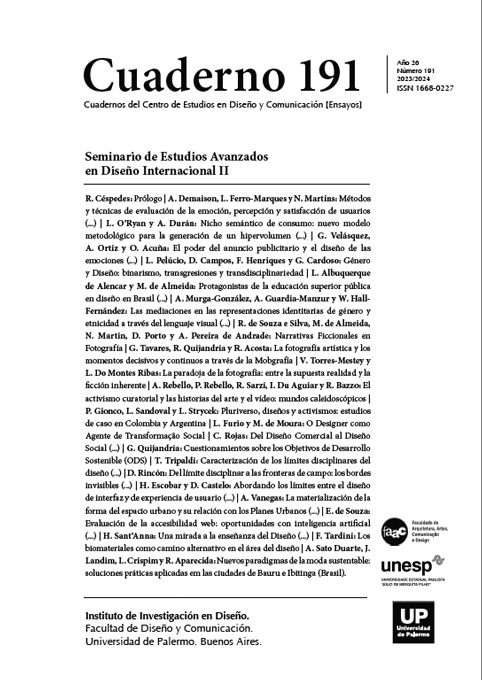Nuevos paradigmas de la moda sustentable: soluciones práticas aplicadas em las ciudades de Bauru e Ibitinga (Brasil)
Resumen
La cadena textil y de confecciones es una de las más extensas y complejas que existen, involucrando varios segmentos industriales autónomos cuya interacción es fundamental para su organización.
Citas
ABNT – Associação Brasileira de Normas Técnicas (2004). NBR 10.004: 2004. Resíduos sólidos – Classificação. 71p.
Barnard, M. (2014). Fashion theory: An introduction. Routledge.
Bridgens, B., Powell, M., Farmer, G., Walsh, C., Reed, E., Royapoor, M., Gosling, P., Hall, J., Heidrich, O., (2018). Creative upcycling: reconnecting people, materials and place through making. J. Clean. Prod. 189, 145e154.
Borges, A. (2019). Design+ Artesanato: o caminho brasileiro. Editora Terceiro Nome.
Coppola, C., Vollero, A., & Siano, A. (2021). Consumer upcycling as emancipated selfproduction: Understanding motivations and identifying upcycler types. Journal of Cleaner Production, 285, 124812.
Echeverria, C. A., Handoko, W., Pahlevani, F., & Sahajwalla, V. (2019). Cascading use of textile waste for the advancement of fibre reinforced composites for building applications. Journal of Cleaner Production, 208, 1524-1536.
Fletcher, K., & Grose, L. (2012). Fashion & sustainability: Design for change. Hachette UK.
Ha-Brookshire, J., & Labat, K. L. (Eds.). (2015). Envisioning textile and apparel research and education for the 21st century (p. 38). International Textile and Apparel Association. IBGE – Instituto Brasileiro de Geografia e Estatística. (2021). Estimativas da população residente para os Municípios e para as Unidades da Federação brasileiros, com data de referência em 1º de julho de 2021. Disponível em: https://ftp.ibge.gov.br/Estimativas_de_Populacao/Estimativas_2021/estimativa_dou_ 2021.pdf. Acesso em 21/12/2021.
IEMI (2021). Brasil Têxtil 2021. Disponível em: https://www.yumpu.com/xx/document/read/64962385/brasil-textil-2021-abit. Acesso em 27/10/2022.
Islam, S. (2021). Waste management strategies in fashion and textiles industry: Challenges are in governance, materials culture and design-centric. In Waste Management in the Fashion and Textile Industries (pp. 275-293). Woodhead Publishing.
Jia, F., Yin, S., Chen, L., & Chen, X. (2020). The circular economy in the textile and apparel industry: A systematic literature review. Journal of Cleaner Production, 259, 120728.
Lorenzetti, L. (2018). A importância do reaproveitamento de resíduos têxteis em São Paulo. Disponível em: . Acesso em 18/02/2020.
MacArthur, E. (2017). A new textiles economy: Redesigning fashion’s future. 2017. Disponível em: . Acesso em: 25/08/2021.
Madeira, G. N. R. M. S. (2021). Superação das barreiras tecnológicas pelo setor têxtil segundo as premissas de Economia Circular.
Matushima, M. K. (2005). Especialização produtiva e aglomeração industrial: uma análise da indústria de confecções de Ibitinga-SP.
Parisi, M. L., Fatarella, E., Spinelli, D., Pogni, R., & Basosi, R. (2015). Environmental impact assessment of an eco-efficient production for coloured textiles. Journal of Cleaner Production, 108, 514-524. Prefeitura De Ibitinga (2022). Disponível em: https://www.ibitinga.sp.gov.br/cidade/aspectos-fisicos. Acesso em 26/09/2022.
Ribul, M., Lanot, A., Pisapia, C. T., Purnell, P., McQueen-Mason, S. J., & Baurley, S. (2021). Mechanical, chemical, biological: Moving towards closed-loop bio-based recycling in a circular economy of sustainable textiles. Journal of Cleaner Production, 326, 129325.
Reilly, A., & Kaiser, S. (2015). Imagining a Future without our Field. Envisioning Textile and Apparel Research and Education for the 21st Century, 11, 8-10.
Rodrigues, P. de C. (2014). A Produção de Sentidos sobre Inovação: Estudo de Caso sobre a Agência USP de Inovação, Dissertação de Mestrado, USP, São Paulo.
Sachs, I. (2000). Caminhos para o desenvolvimento sustentável. Editora Garamond.
SEBRAE - Serviço Brasileiro de Apoio às Micro e Pequenas Empresas. (2021). Distribuição dos estabelecimentos ativos 2021. Disponível em: https://datampe.sebrae.com.br/profile/geo/ibitinga#empresas-por-atividade-principal. Acesso em 18/09/2022.
Shirvanimoghaddam, K., Motamed, B., Ramakrishna, S., & Naebe, M. (2020). Death by waste: Fashion and textile circular economy case. Science of the Total Environment, 718, 137317.
Shrivastava, A., Jain, G., Kamble, S. S., & Belhadi, A. (2021). Sustainability through online renting clothing: Circular fashion fueled by instagram micro-celebrities. Journal of Cleaner Production, 278, 123772.
Singer, P. (2002). Introdução à economia solidária. São Paulo: Fundação Perseu Abramo.
Szaky, T., (2014). OutsmartWaste: the Modern Idea of Garbage and How to Think Our Way Out of it. Berrett-Koehler, San Francisco, CA.
Tobler-Rohr, M. I. (2011). Handbook of sustainable textile production. Elsevier.
WTO - World Trade Organization. (2021). World Trade Statistical Review 2021. Disponível em: https://www.wto.org/english/res_e/statis_e/wts2021_e/wts2021_e.pdf. Acesso em: 27/10/2022.
Los autores/as que publiquen en esta revista ceden los derechos de autor y de publicación a "Cuadernos del Centro de Estudios de Diseño y Comunicación", Aceptando el registro de su trabajo bajo una licencia de atribución de Creative Commons, que permite a terceros utilizar lo publicado siempre que de el crédito pertinente a los autores y a esta revista.


